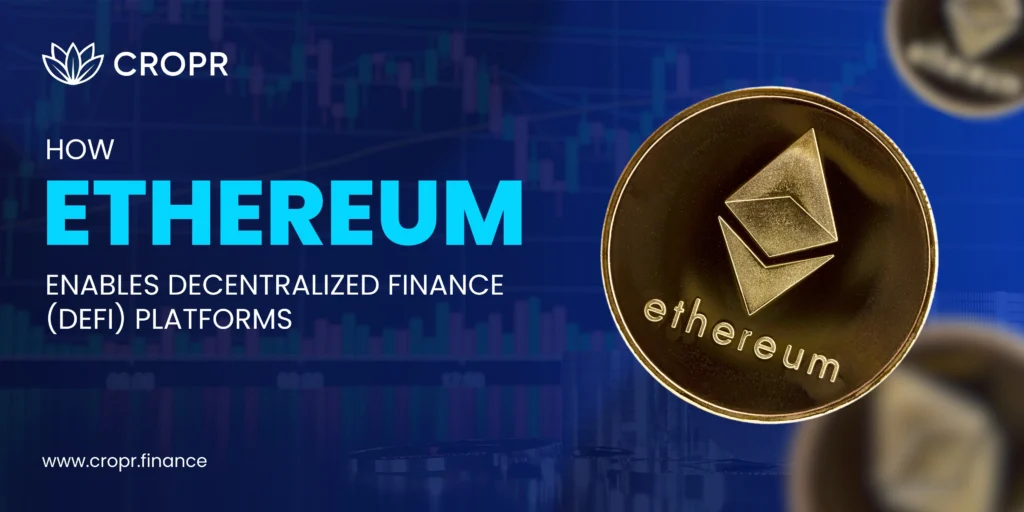Decentralized Finance (DeFi) is changing the way financial services operate. Instead of relying on centralized institutions, users can now borrow, lend, trade, or swap using open, transparent protocols. This shift toward decentralized access has opened up financial participation to anyone with an internet connection.
At the core of this system is Ethereum—a smart contract blockchain that serves as the base layer for most DeFi applications. While the concept of decentralized finance existed before, Ethereum’s architecture enabled it to function at scale. For anyone looking to participate in DeFi, whether through lending, staking, or managing assets, understanding Ethereum’s role is essential.
What is Ethereum?
Ethereum is a programmable blockchain network built to support applications beyond simple transactions. Unlike Bitcoin, which focuses on peer-to-peer payments, Ethereum enables smart contracts, lines of code that execute automatically when conditions are met.
Its native currency, Ether (ETH), powers these contracts by covering network costs (gas fees) and is commonly used within DeFi systems as a unit of exchange, store of value, or collateral.
What sets Ethereum apart is its developer ecosystem and flexibility. With tools like Solidity (its primary programming language) and widely used frameworks like Web3.js, developers can build complex financial logic into applications that run without central authority.
How Ethereum Enables DeFi Applications
Ethereum provides the core infrastructure that DeFi platforms rely on. It offers a trustless environment, meaning users don’t need to rely on intermediaries to enforce agreements. Instead, logic embedded in smart contracts handles transactions autonomously.
Here’s how Ethereum supports some of the key use cases in the DeFi space:
- Lending and Borrowing: Platforms like Compound allow users to supply crypto and earn interest or take out loans by providing collateral. Ethereum handles the enforcement, custody, and liquidation logic automatically.
- Token Swaps and AMMs: Uniswap, one of the most prominent Ethereum DEXs, uses smart contracts to enable peer-to-peer trading through automated market-making mechanisms.
- Synthetic Assets: Protocols like Synthetix issue synthetic tokens that mirror the value of real-world assets. These systems rely on Ethereum for collateral management and price oracle integration.
- Stable Assets: DAI, a decentralized stablecoin issued by MakerDAO, is backed by crypto collateral managed entirely on Ethereum. It provides a reliable unit of account without centralized backing.
Each of these services operates through Ethereum’s consensus and settlement layer, removing the need for banks, custodians, or clearinghouses.
Real Examples of DeFi Protocols on Ethereum
Ethereum is home to some of the most influential DeFi platforms:
- MakerDAO: Facilitates the creation of DAI, a decentralized stablecoin, through crypto-collateralized positions.
- Uniswap: Enables token swaps through smart contracts without relying on order books or centralized liquidity providers.
- Yearn Finance: Offers automated yield strategies by routing user funds across protocols to optimize returns.
Each of these projects illustrates a different application of Ethereum’s capabilities, from collateral management to automated trading and optimization. They operate independently, but all rely on Ethereum for security, execution, and state persistence.
CROPR Finance follows this same philosophy. It simplifies multi-chain DeFi portfolio tracking—making Ethereum-based positions, staking, and lending easier to monitor in one place. As users branch into Arbitrum, Optimism, or Polygon, CROPR keeps it unified without added complexity.
What Lies Ahead for Ethereum and DeFi
Ethereum is evolving with solutions aimed at fixing existing bottlenecks. Rollups, proto-dank sharding, and other scaling initiatives are expected to increase capacity while reducing fees and making DeFi more accessible.
At the same time, DeFi is branching into new categories:
- Insurance: Decentralized risk pools to protect against hacks or volatility
- Forecasting: Prediction markets built on Ethereum logic
- Asset Tokenization: Converting physical or off-chain assets into Ethereum-based tokens
Institutions are beginning to explore Ethereum-compatible networks for settlement and asset issuance, signaling a gradual convergence of traditional and decentralized finance.
The next wave of growth will depend not just on new products but also on improving usability and compliance without compromising Ethereum’s open model.
Takeaway
Ethereum provided the foundation on which decentralized finance could scale, adapt, and reach millions of users. Its smart contract capabilities turned code into trust and removed the friction traditionally associated with financial services.
From liquidity protocols to lending vaults, Ethereum remains at the center of the DeFi movement, not just as a platform but as a design philosophy based on transparency, openness, and programmable control.
And that’s where CROPR fits in. We believe in making this space easier to navigate. Whether you’re staking, bridging, lending, or swapping—our real-time dashboard gives you a complete view across Ethereum and beyond.
And this is just the beginning.
Try our live demo and see how simple DeFi portfolio tracking can be.

